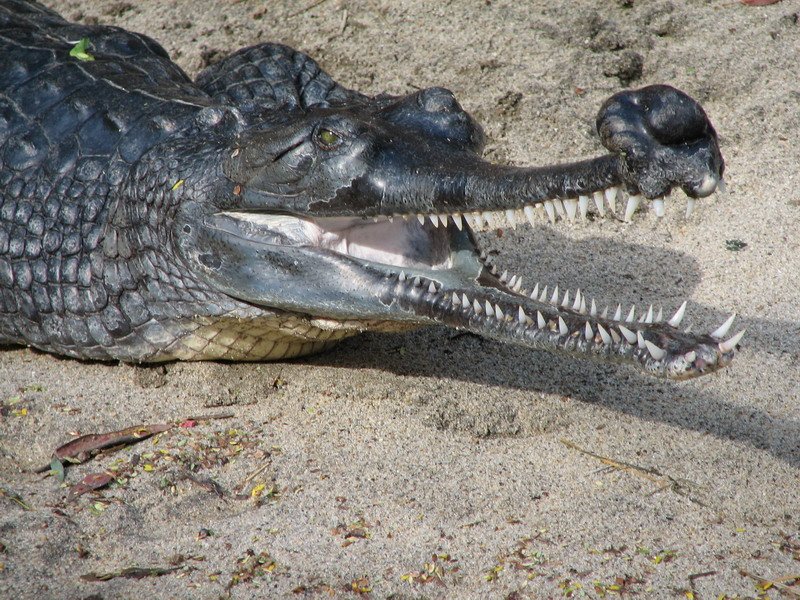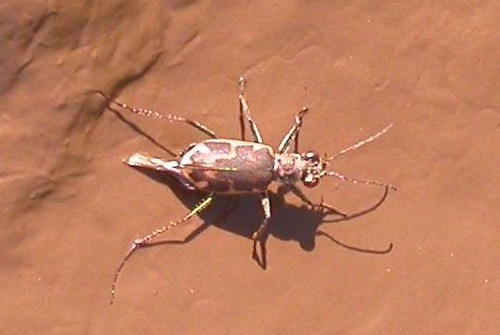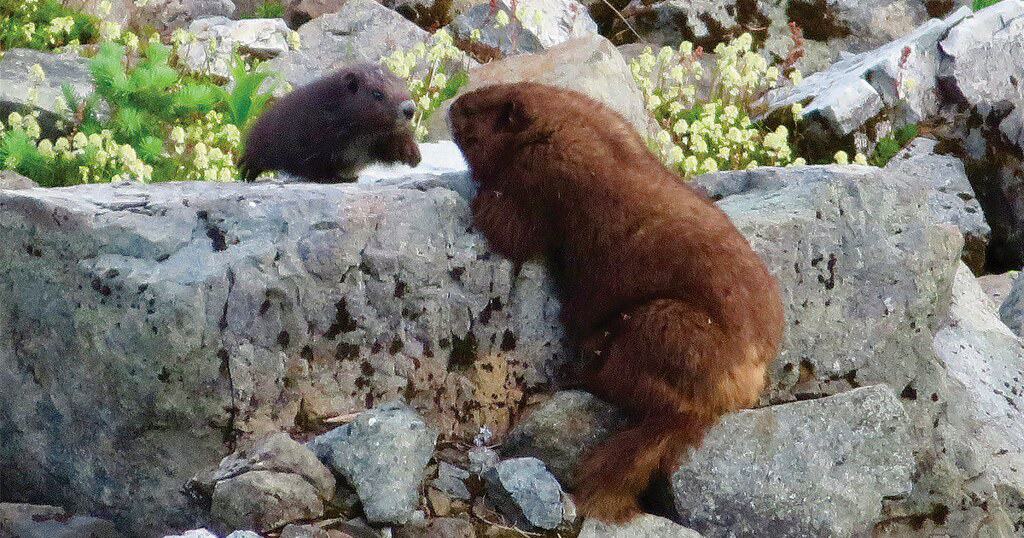While it’s too late to save the plants and animals that have already gone extinct, it is possible to help the ones that still exist but are facing extinction. What eight animals need help because they are going extinct today?
One of the largest drivers behind the mass extinctions occurring today is human development and commerce. The way we currently grow and raise food, procure water, and transport resources hurt the environment. Almost all of the extinctions occurring today can be reversed if humans change how they interact with the world.
Let’s look at eight animals in need of help that are going extinct now.
8 Animals That Are Going Extinct
These are eight animals that need help so they don’t go extinct:
- Giant Panda
- Sumatran Tiger
- Gharial
- Salt Creek Tiger Beetle
- Yangtze Finless Porpoise
- Cross River Gorilla
- Vancouver Island Marmot
- Bengal Roof Turtle
Giant Panda

Giant pandas have been on the verge of extinction for many years, but there are nearly double in the wild today than there were in the 1970s.
©iStock.com/wrangel
The giant panda is one of the most famous of all animals on earth that are almost extinct. It is endemic to China and now only lives in 6 mountain ranges in the country. They can be quite dangerous but they’re generally solitary animals.
Giant pandas spend most of their time foraging for bamboo but their habitats are being fragmented and destroyed. However, the giant panda is experiencing a stabilization of its population due to successful conservation efforts. They’re folivores which means they eat almost an entire diet made of leaves.
When conservation efforts began in the 1970s, there were around 1,000 pandas in the wild. Today, that population size has nearly doubled. There is also a sizeable population in captivity.
Sumatran Tiger

Due to human expansion, Sumatran tigers are poised to be the first
extinct big cat
of the 21st century.
©Linda George/Shutterstock.com
Coming in at a little over 300 pounds on average, Sumatran tigers are the smallest kind of tiger in the world. They’re incredibly rare and they only live on the island of Sumatra in Indonesia. They evolved into a separate species thousands of years ago when sea levels rose and Sumatra became isolated from the mainland.
Because they’re on a tropical island, they have webbing between their toes to help them navigate many types of waterways. They’re carnivores that eat monkeys, deer, boar, tapir, and fish. These tigers are known to target human livestock.
Human expansion and development within their territory is their biggest threat. At the rate they’re disappearing, they’re slated to be the 21st century’s first extinct big cat. There are around 250 captive individuals that are at the center of conservation programs around the world.
Gharial

There are likely only a few hundred gharials left in the wild.
©Justin Griffiths / Public Domain, Wikimedia Commons – License
Only isolated populations of gharials exist in Nepal and northern India when previously they also had ranges in Pakistan, Myanmar, Bhutan, and Bangladesh. The gharial is endemic to Southeast Asia and hunts for fish in the deep waters found in the rivers on the Indian Subcontinent.
It has a long and thin snout and it’s one of the largest crocodiles on earth. Male gharials have a protrusion on their noses that helps them amplify their snorts. The noise they make can be heard for miles.
By the 1970s, it was recognized that the gharials were declining drastically in number. Today, more than 96% of their historic population is gone and there are probably only a few hundred individuals in the wild. India attempted to protect these animals under its Wildlife Protection Act and conservation efforts, including hatcheries, had been established.
While efforts succeeded in reintroducing individuals to the wild for a time, locals were not involved in the conservation efforts so gharials still face dramatic threats that continue to reduce their numbers. They’re being killed off because they are a source of medicine, food, and skin. Environmental degradation compounds this problem but reintroduction efforts have ceased.
Salt Creek Tiger Beetle

A Salt Creek
tiger
beetle.
©USFWS Mountain-Prairie/Flickr – License
This beetle is only found in two of Nebraska’s counties. They live exclusively in saline wetlands around the city of Lincoln. Their populations have been declining over the last 30 years and efforts to reintroduce them to their native habitat have proven inconclusive.
Yangtze Finless Porpoise

Endemic to the Yangtze River in China, the Yangtze finless porpoise is critically endangered.
©Yohkawa/Wikimedia Commons – License
The Yangtze finless porpoise is endemic to the Yangtze River in China but it is critically endangered. This is the last existing freshwater porpoise in the world. Their populations are believed to be stabilizing though there are only 1,000 or so individuals in the wild.
The Yangtze River used to be a biodiverse place that supported many large aquatic mammals. The recently extinct Yangtze River dolphin used to occupy the same water spaces as the Yangtze finless porpoise.
In 2021, China made these porpoises a first-level protected species. What led to the demise of the dolphin is also ending the porpoise. Pollution and the overfishing of prey by humans are the primary culprits.
Cross River Gorilla

With just about 300 left in the wild, the Cross River
gorilla
is the most endangered gorilla on earth.
©Kit Korzun/Shutterstock.com
These are the most endangered gorillas on earth with only 300 or so individuals left in the wild. They live in the forests along the border between Nigeria and Cameroon. They’re a subspecies of the western gorilla that was identified in 1904.
The Cross River gorilla is targeted as a source of bush meat and its habitat is being destroyed. They try their best to avoid people and the first videos of them weren’t taken until 2009.
Their thumbs are more flexible than other western gorillas because they eat a large amount of ginger that requires specialized peeling. They’re dexterous, and they’re the smallest gorilla of their kind.
Vancouver Island Marmot

Like the Cross River gorilla, there are only around 300 Vancouver Island Marmots left in the wild.
©Province of British Columbia/Flickr – License
There are only 300 of these animals left in the wild though there is a promising captive breeding program taking place. Their wild numbers do continue to fluctuate and genetic diversity is a pressing issue. For a brief period in the 1990s, they were momentarily extinct in the wild.
Marmots are large ground squirrels and this particular marmot is the most endangered mammal in Canada. It is also endemic to Vancouver Island. It’s about the size of a house cat and weighs around 11 lbs.
They live at higher elevations in natural meadows that occur in the forest on their island. These spaces provide the appropriate soil for burrowing which they rely on for shelter and so they can hibernate. They’re opportunistic herbivores that eat a large variety of grasses, flowers, and herbs.
Bengal Roof Turtle

There are fewer than 400 Bengal roof turtles left in the wild.
©CLPramod/Wikimedia Commons – License
Also called red-crowned roof turtles, these animals are endemic to South Asia. They now only live in a small portion of the Chambal River in India though they used to live in Nepal and Bangladesh. Predation by jackals is also a huge threat to the surviving members of this species.
There are fewer than 400 individuals left in the wild. These turtles are succumbing to overharvesting as fishing bycatch and food while facing the consequences of habitat destruction.
India is trying to conserve these animals by protecting their remaining habitat and breeding programs are in place. They’re large turtles that weigh up to 50 lbs. They live exclusively on aquatic plants that are being wiped out by pollution and changing water flows as waterways are developed for power infrastructures.
Up Next…
The photo featured at the top of this post is © Linda George/Shutterstock.com
Thank you for reading! Have some feedback for us? Contact the AZ Animals editorial team.






